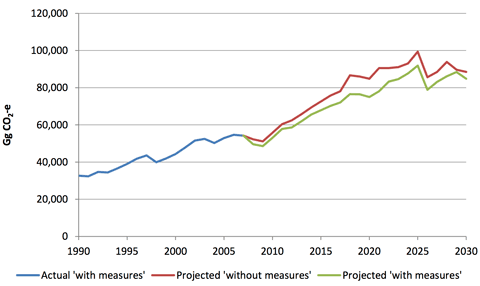 Two major new government reports on New Zealand’s emissions projections and the expected impacts of four degrees of warming on NZ agriculture were released without fanfare last Friday — the timing clearly designed to minimise media fallout from reports that highlight the paucity and ineffectiveness of current climate policy settings.
Two major new government reports on New Zealand’s emissions projections and the expected impacts of four degrees of warming on NZ agriculture were released without fanfare last Friday — the timing clearly designed to minimise media fallout from reports that highlight the paucity and ineffectiveness of current climate policy settings.
Climate change minister Tim Groser dutifully issued a press release welcoming the release of New Zealand’s Sixth National Communication under the United Nations Framework Convention on Climate Change and Kyoto Protocol, the first such report since 2009. Groser praised government policies, but failed to draw attention to the fact that his own report shows NZ emissions failing to meet the government’s targeted cuts, or that current policy settings will do little to reduce them — let alone achieve reductions by comparison with 1990 levels. This graph ((From p126 of the report)) of actual and projected net emissions out to 2030 tells the story of the Key government’s abject policy failure:

The blue line is actual emissions up to 2008, “with measures” — that is, as affected by policies to reduce emissions. The red line is emissions projected out to 2030 assuming no action to reduce emissions, the green line the emissions that will result after current policy settings are taken into account. Both green and red lines rise substantially up to 2030, and end up at the virtually the same point ((88 Gg CO2e without measures, 84 Gg with.)) — more than double NZ’s net emissions in 1990.
In other words, Tim Groser and his cabinet colleagues have created a suite of policies designed to increase New Zealand’s emissions at a time when they are supposed to be being reduced, and which will miserably fail to meet the government’s own target of a 5% reduction in emissions (using the 1990 baseline) by 2020.
The second report released last week is much the more interesting of the two, and makes grim reading for anyone trying to play down the seriousness of the likely changes that confront NZ and its farmers and growers. Four Degrees of Global Warming: Effects on the New Zealand Primary Sector (full report and summary available here) was placed on the Ministry of Primary Industries web site last Friday, but was spotted by TV3 News today.
The report is the first study to consider the likely impacts of warming at the upper end of global expectations, and projects climate impacts across the country and on pasture and forest productivity based on two different climate model projections. The pattern of changes is much as described in previous studies — warming spreading down from the north, wetter in the west and drier in the east, greater rainfall intensities, bigger floods and longer droughts — but with much sharper increases in these parameters.
Under the four degrees of warming scenario:
- frosts are expected to disappear from all but the highest parts of the North Island and much of the coastal South Island
- the amount of rain falling in extreme events is expected to increase by 32%
- river flows will experience seasonal changes as snowfall declines
- periods of maximum irrigation demand are likely to coincide with extended periods of low flows in major catchments
- a massive increase in the growing degree days experienced in all regions, with Canterbury almost as warm as Northland
- fruit crops requiring winter chilling (apricots, kiwi) will have to move south
- wine growing regions will move and different grape varietals will be required
- significant increase in heat stress on dairy cattle
The report finds that the most positive impact will be on forestry, where a combination of warming and CO2 fertilisation is expected to increase yields in both Pinus radiata and eucalyptus plantations.
This is more than a little ironic, given that the Emissions Trading Scheme policy settings and low carbon price have reduced the attractiveness of forestry planting as a carbon sink. The one thing that might do well in a warmer NZ is the one thing the government seems unable to incentivise with a handout. Perhaps James Cameron could make a film about it?

There’s only one thing to do: build some big nuclear power stations as Hansen suggests.
Not necessary in NZ (and nuclear is off-topic under this post – try the recent open thread).
Was it ignorance or cynicism that guided the PM’s remarks on TV3, acknowledging the threat (albeit with an ‘if’) and claiming that the ETS and some government funding of agricultural research make up a meaningful response to it?
Brian, not ignorance. Key isnt thick and cant possibly be taken in by people like Moncton.So its cynicism, and pandering to lobby groups.
It’s government policy, built into law. Climate change can’t be considered by courts (in the RMA for instance) because that’s taken care of by a placebo refered to as the ETS!
Nigel , you may call me cynical , but wasn’t the ETS ever only “window -dressing” / pandering to lobby groups?
It was simply a way of NZ being seen to be doing its bit. No other nation did anything meaningful , and we did likewise – absolutely nothing.
Biofarmer, I tend to think the ETS was originally meaningful, but has now been watered down to nothing, and yes lots of countries are making token gestures. However British Columbia appears to have a “carbon tax” that is achieving more meaningful results.
Id, agree. ETS was a good idea in principle. Force emitters to pay for their emissions and reward those who reduce theirs. But the complexities of the implementation and the loopholes have turned it into a farce.
What we will need is to tax fossil fuels at the source to build the cost of the emissions into the system at the point of production of the fuels.
Some thoughts on our failing ETS and how to fix it:
http://euanmason.blogspot.co.nz/
It’s not just erosion prone North Island hill country that should revert to forest – a lot of the tussock country in the South Island could, and should, go back to trees. People will say it’s ‘iconic’ and attracts tourists etc, but a lot of it used to be beech pre-Maori, and with warmer conditions the trees would grow faster. They might help equalise river flows too, if we lose the snow pack currently providing free water storage. I thought New Zealand must be the only place where conservationists spent their weekends tearing seedling trees out instead of planting them, but George Monbiot has been preaching lately about letting upland Britain go bush
http://www.monbiot.com/2013/05/23/whats-missing-from-this-picture/
Very interesting, Euan – and worth getting out to a wide audience. Could I post the piece at Hot Topic as a guest post?
It would be very fitting indeed for NZ to reverse the deforestation trend and start planting new forests. It is amazing what could be achieved world wide with such a campaign. Thank you bringing this to our attention Euan!
Ultimately, looking at the CO2 trend curves and seeing the seasonal zig-zag with their significant gradients, an obvious solution to the CO2 issue is staring at us right there.
Hi Gareth,
Yes, that would be fine. How best to make the transfer to your site?
Kind regards,
Euan
Thanks! Email on its way…